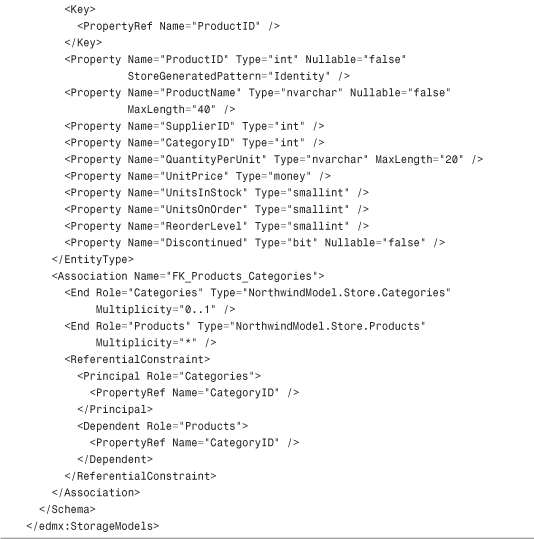- Title Page
- Copyright Page
- Dedication
- Contents at a Glance
- Table of Contents
- Foreword
- About the Author
- Acknowledgments
- We Want to Hear from You!
- Reader Services
- Part I. Learning the Basics of VB
- Chapter 1. Introducing the .NET Framework 4.0
- Chapter 2. Getting Started with the Visual Studio 2010 IDE
- Chapter 3. The Anatomy of a Visual Basic Project
- Chapter 4. Data Types and Expressions
- Chapter 4. Data Types and Expressions
- Common Type System
- Understanding Value Types
- Understanding Reference Types
- Differences Between Value Types and Reference Types
- Converting Between Value Types and Reference Types
- Conversion Operators
- Working with .NET Fundamental Types
- Common Operators
- Iterations, Loops, and Conditional Code Blocks
- Chapter 5. Debugging Visual Basic 2010 Applications
- Chapter 6. Handling Errors and Exceptions
- Part II. Object-Oriented Programming with Visual Basic 2010
- Chapter 7. Class Fundamentals
- Chapter 8. Managing an Object’s Lifetime
- Chapter 9. Organizing Types Within Namespaces
- Chapter 10. Modules
- Chapter 11. Structures and Enumerations
- Chapter 12. Inheritance
- Chapter 13. Interfaces
- Chapter 14. Generics and Nullable Types
- Chapter 15. Delegates and Events
- Chapter 16. Working with Collections
- Chapter 16. Working with Collections
- Understanding Collections Architecture
- Working with Nongeneric Collections
- The ArrayList Collection
- The Queue Collection
- The Stack Collection
- The HashTable Collection
- The ListDictionary Collection
- The OrderedDictionary Collection
- The SortedList Collection
- The HybridDictionary Collection
- The StringCollection Collection
- The StringDictionary Collection
- The NameValueCollection Collection
- The BitArray Collection
- The Bitvector32 Collection
- Working with Generic Collections
- The List(Of T) Collection
- Working with Collection Initializers
- The ReadOnlyCollection(Of T) Collection
- The Dictionary(Of TKey, TValue) Collection
- The SortedDictionary(Of TKey, TValue) Collection
- The ObservableCollection(Of T) Collection
- The ReadonlyObservableCollection(Of T) Collection
- The LinkedList(Of T) Collection
- The Queue(Of T) and Stack(Of T) Collections
- Building Custom Collections
- Concurrent Collections
- Chapter 17. Visually Designing Objects
- Chapter 18. “Generate From Usage” Coding Techniques
- Part III. Advanced VB Language features
- Chapter 19. Manipulating Files and Streams
- Chapter 20. The My Namespace
- Chapter 21. Advanced Language Features
- Part IV. Data Access with ADO.NET and LINQ
- Chapter 22. Introducing ADO.NET and DataSets
- Chapter 23. Introducing LINQ
- Chapter 24. LINQ to Objects
- Chapter 24. LINQ to Objects
- Introducing LINQ to Objects
- Querying in Memory Objects
- Introducing Standard Query Operators
- Projection Operators
- Restriction Operators
- Aggregation Operators
- Understanding the Let Keyword
- Conversion Operators
- Generation Operators
- Ordering Operators
- Set Operators
- Grouping Operators
- Union Operators
- Equality Operators
- Quantifiers
- Concatenation Operators
- Elements Operators
- Partitioning Operators
- Chapter 25. LINQ to SQL
- Chapter 26. LINQ to DataSets
- Chapter 27. Introducing ADO.NET Entity Framework
- Chapter 28. Manipulating Xml Documents with LINQ and Xml Literals
- Chapter 29. Overview of Parallel LINQ
- Part V. Building Windows Applications
- Chapter 30. Creating Windows Forms 4.0 Applications
- Chapter 31. Creating WPF Applications
- Chapter 31. Creating WPF Applications
- What Is WPF?
- WPF Architecture
- Building WPF Applications with Visual Studio 2010
- Understanding the eXtensible Application Markup Language (XAML)
- Understanding Visual Tree and Logical Tree
- Handling Events in WPF
- Arranging Controls with Panels
- Managing Windows
- Introducing the Application Object
- Brief Overview of WPF Browser Applications
- Chapter 32. WPF Common Controls
- Chapter 32. WPF Common Controls
- Introducing WPF Controls Features
- Understanding the ContentControl
- Understanding Common Controls
- Border
- Button
- Calendar
- CheckBox
- ComboBox
- DataGrid
- DatePicker
- DocumentViewer
- Ellipse
- Expander
- Frame
- GroupBox
- Image
- Label
- ListBox
- ListView
- MediaElement
- Menu
- PasswordBox
- ProgressBar
- RadioButton
- Rectangle
- RichTextBox
- ScrollBar
- ScrollViewer
- Separator
- Slider
- StatusBar
- TabControl
- TextBlock
- TextBox
- ToolBar
- TreeView
- WebBrowser
- WindowsFormsHost
- Using Common Dialogs
- Chapter 33. Brushes, Styles, Templates, and Animations in WPF
- Chapter 34. Manipulating Documents and Media
- Chapter 35. Introducing Data-Binding
- Chapter 36. Localizing Applications
- Part VI. Building Web Applications
- Chapter 37. Building ASP.NET Web Applications
- Chapter 38. Publishing ASP.NET Web Applications
- Chapter 39. Building Rich Internet Applications with Silverlight
- Chapter 39. Building Rich Internet Applications with Silverlight
- Introducing Silverlight
- Creating Silverlight Projects with Visual Basic 2010
- Adding Controls and Handling Events
- Playing Media
- Animating UI Elements
- Introducing Navigation Applications
- Introducing WCF RIA Services
- “Out of Browser” Applications
- Chapter 40. Building and Deploying Applications for Windows Azure
- Part VII. Networking and Exposing Data Through Networks
- Chapter 41. Creating and Consuming WCF Services
- Chapter 42. Implementing and Consuming WCF Data Services
- Part VIII. Advanced .NET Framework with VB 2010
- Chapter 43. Serialization
- Chapter 44. Processes and Multithreading
- Chapter 45. Parallel Programming
- Chapter 46. Working with Assemblies
- Chapter 47. Reflection
- Chapter 48. Coding Attributes
- Chapter 49. Platform Invokes and Interoperability with the COM Architecture
- Chapter 50. Documenting the Source Code
- Chapter 51. Advanced Compilations with MSBuild
- Chapter 52. Building Customizations for Microsoft Office
- Part IX. Applications Deployment
- Chapter 53. Understanding the Global Assembly Cache
- Chapter 54. Setup & Deployment Projects for Windows Installer
- Chapter 55. Deploying Applications with ClickOnce
- Part X. Mastering the Visual Studio 2010 IDE
- Chapter 56. Advanced IDE Features
- Chapter 57. Introducing the Visual Studio Extensibility
- Chapter 58. Advanced Analysis Tools
- Chapter 59. Testing Code with Unit Tests, Test-Driven Development, and Code Contracts
- Appendixes
- Index
Understanding Entity Data Models
The best way to understand Entity Data Models (from here on just EDMs for brevity) is to create one. First, create a new Visual Basic project for the Console and name it EntityFramework. The next steps require the Northwind database that you installed in Chapter 25, “LINQ to SQL.” Right-click on the project name in Solution Explorer and select Add New Item. When the Add New Item dialog appears, move to the Data Node, select the ADO.NET Entity Data Model item template, and name it Northwind.edmx, as shown in Figure 27.1.
Figure 27.1 Adding a new Entity Data Model.
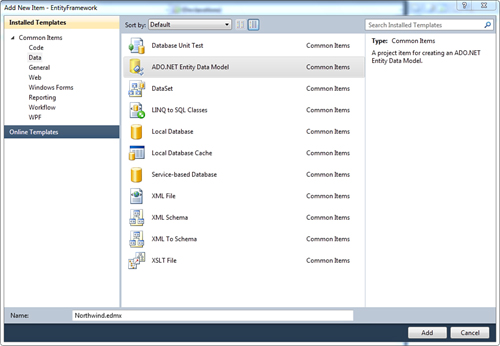
When you click Add, the Entity Data Model Wizard starts. In the first screen you need to specify the source for the EDM. With EF 4 you can create EDMs starting from an existing database or modeling custom EDMs from scratch. Select the existing database options, as shown in Figure 27.2.
Figure 27.2 Creating an EDM from an existing database.

The next screen is important because it requires the specification of the database. You can click New Connection or select one of the favorite connections from the appropriate combo box. Figure 27.3 shows how on my machine the connection points to Northwind as it is available on SQL Server.
Figure 27.3 Choosing the database and connection settings.
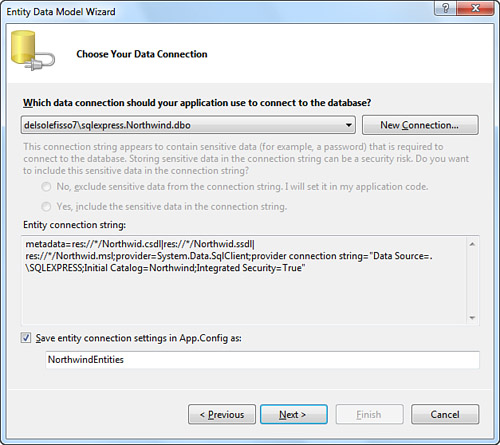
Notice how the connection string is represented in the dialog box. Also notice that this is not the usual connection string, because it contains metadata information that will be clearer when the EDMs’ infrastructure is explained. You decide whether to save the string in the configuration file. The next step is crucial, because you have to select what database objects you want to be mapped into the EDM. Figure 27.4 shows the dialog box.
Figure 27.4 Selecting objects for the new EDM.
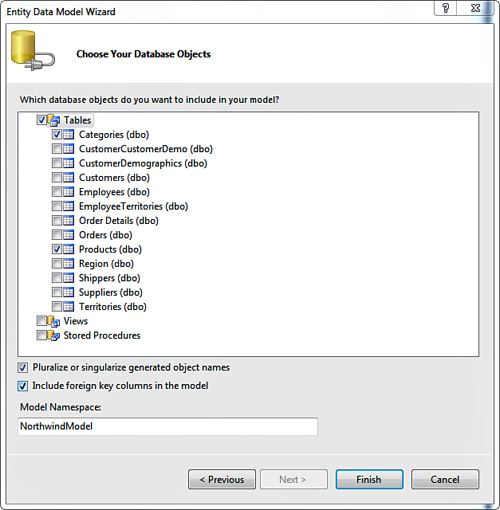
Foreign Key Columns Support
The ADO.NET Entity Framework 4 supports mapping foreign keys from the database into the model. This is the reason why you find a new checkbox in the Entity Data Model wizard, as shown in Figure 27.4. Simply select the checkbox in order to add the foreign key’s support.
Also notice how you are required to specify a model namespace. This is important because the namespace stores Visual Basic definitions for objects that are mapped to database objects, which are explained later. You can write your own or leave the default identifier unchanged. At the moment, just choose the Categories and Products tables and then click Finish. After a few moments, when Visual Studio generates the code for the object model, the EDM Designer opens as shown in Figure 27.5.
Figure 27.5 The EDM Designer for Visual Studio.
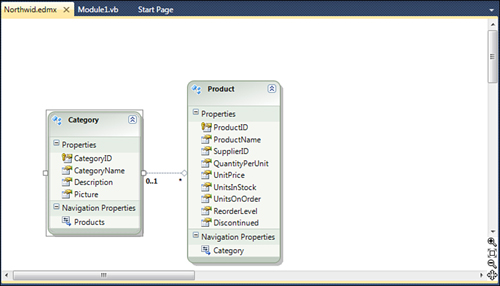
The object model available in the Visual Studio designer is, behind the scenes, defined by a new Xml document that is the schema for the Entity Data Model. This Xml file is the one with the .edmx extension, in our case Northwind.edmx. The schema is divided into three sections that are summarized in Table 27.1.
Table 27.1 Sections of the Entity Data Model

Much work is accomplished behind the scenes by a command-line tool named EdmGen.exe that is invoked by Visual Studio. To understand how an EDM is composed, in Solution Explorer right-click the Northwind.edmx file; select Open With, and when the Open With dialog appears, double-click the Xml editor option. At this point Visual Studio shows the content of the EDM as an Xml file instead of the designer. The file contains three sections as described in Table 27.1. Listing 27.1 shows the CDSL definition (which is actually the second section in the XML file).
Listing 27.1 Conceptual Schema Definition Language
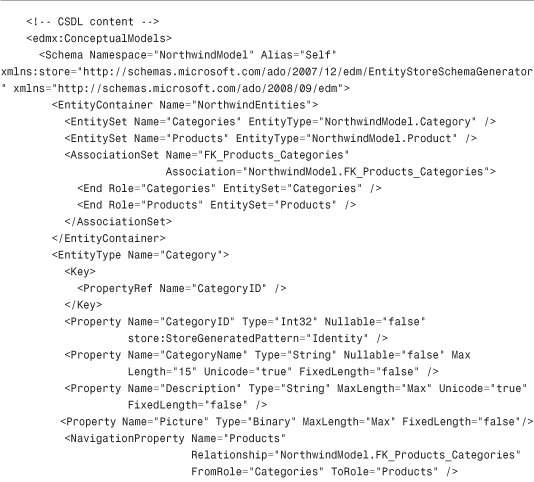
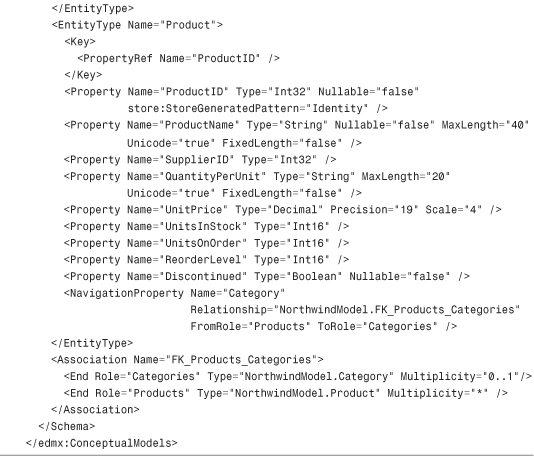
You can notice how entities (EntityType) are defined along with scalar properties (Property), relationships (Association), entity sets (EntitySet), and a container named NorthwindEntities. The next section that we consider is the SSDL, which is constituted by the Xml markup code shown in Listing 27.2 and which is actually the first section in the XML file.
Listing 27.2 The Store Schema Definition Language
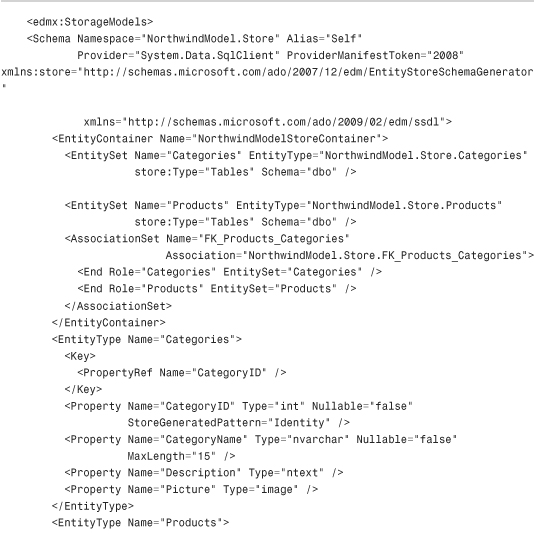
Basically this schema is similar to the previous schema, except that it represents the database structure as you can see from type definition within Property elements. The last schema is the Mapping Definition Language that is illustrated in Listing 27.3.
Listing 27.3 Mapping Definition Language
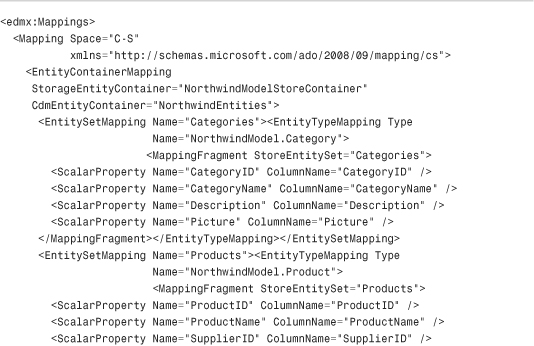

The content of the MDL is quite simple, in that each ScalarProperty represents an entity’s property and establishes mapping between the property and the related column name in the database table.
-
No Comment

